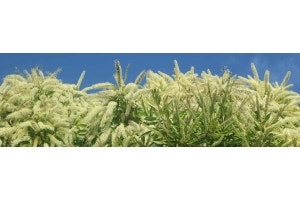
What Is An Acid or Alkaline Soil?
 Cast your mind back to early schooldays, when you were conducting experiments in science class... Do you remember taking a strip of paper and dipping it in a solution, watching the paper turn red or blue?
Cast your mind back to early schooldays, when you were conducting experiments in science class... Do you remember taking a strip of paper and dipping it in a solution, watching the paper turn red or blue? (Or a range of colours including lime yellow, green, and purple depending on how sophisticated your test was... )That was a pH test, to determine the acid or alkaline levels of the solution. A low number means acid, a high number, alkaline, and 7.0 is pH neutral - neither acid nor alkaline.

Optimal pH Levels
If you keep fish as a hobby you'll be used to these tests to make sure the water is right for your pets. The process is also very helpful if you keep plants as a hobby, as it makes sure you have the right soil for them to grow and thrive. The optimal pH range for most ornamental garden plants is between 5.5–6.5 - below the neutral pH of 7.0, slightly on the acid side. Too high or low pH - too alkaline or too acid - can restrict the plant's access to nutrients within the soil, especially iron, and prevent it absorbing and making use of them.
 In alkaline soils you'll see the leaves of acid-loving plants turn yellowy from the outside in. The leaf veins often remain green. These leaves are still firm and glossy but not deep green. This is not like the clear yellow of autumn leaves before they fall, or of old leaves dying, or the faded yellow of diseased plants where the leaves are limp and dull. This pH-related leaf-yellowing is called chlorosis, and shows a nutrient deficiency in the plant. There may be nutrients in the soil, but the pH levels are locking up access to them. The reverse is true for alkaline-loving plants in acid soils - they cannot access the micronutrients they need to flourish.
In alkaline soils you'll see the leaves of acid-loving plants turn yellowy from the outside in. The leaf veins often remain green. These leaves are still firm and glossy but not deep green. This is not like the clear yellow of autumn leaves before they fall, or of old leaves dying, or the faded yellow of diseased plants where the leaves are limp and dull. This pH-related leaf-yellowing is called chlorosis, and shows a nutrient deficiency in the plant. There may be nutrients in the soil, but the pH levels are locking up access to them. The reverse is true for alkaline-loving plants in acid soils - they cannot access the micronutrients they need to flourish.

Simple Soil Tests
A simple soil test will tell you what kind of soil you have - acid, alkaline, or neutral - so you can either choose plants that like those conditions, or change the conditions to suit the kind of plants you like.(Tip : the first choice is easier...) The tests are quick and easy to do in your own garden. Test soil from different areas of your garden, especially if it is a large area.There are a few popular families of garden plants that really object to less than perfect pH, and will respond positively when given the ideal soil to grow in.
We'll tell you this in the product descriptions if it is the case.
 A very basic guide to your soil's pH level is to grow a coloured mophead hydrangea - they can turn pink in alkaline soil and blue in acid soil, like a reverse litmus test. However - some hydrangeas have both colours on the bush at once, and some are pH-stable so they won't change colour! A commercial soil test is far more reliable and very easy to do.
A very basic guide to your soil's pH level is to grow a coloured mophead hydrangea - they can turn pink in alkaline soil and blue in acid soil, like a reverse litmus test. However - some hydrangeas have both colours on the bush at once, and some are pH-stable so they won't change colour! A commercial soil test is far more reliable and very easy to do.The good news is that many garden plants are completely unbothered by the pH of the soil they are in, and can adapt to grow in acid or alkaline conditions.
See Acid Loving PlantsSee Alkaline Loving Plants





















